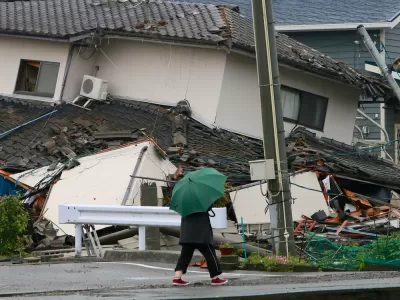A 7.5 magnitude earthquake struck the Indonesian island of Sulawesi on Sept. 25, followed by a massive tsunami. Soil liquefaction caused by the tremor resulted in 1,700 homes being "swallowed" as the soil shifted. Deaths exceeded 1,400 on Oct. 3.

"Dramatic footage has emerged from the city of Palu on the Indonesian island of Sulawesi, with buildings collapsing as the ground slides beneath them," reports Nicola Davis for The Guardian. See the satellite image of Balaroa neighbourhood on October 1. On Wednesday, deaths surpassed 1,400.
Joe Sommerlad of The Independent provides a succinct description of the process of soil liquefaction, explaining what happened on Sulawesi, the etymology of the term, and other quakes where played a role in great death and destruction.
What is liquefaction?
The term refers to saturated sand and silt – that is, ground in which the space between particles is completely filled with water – taking on liquid form after the earth is subjected to aggressive disturbance by a powerful quake. Areas with shallow water tables close to the sea or rivers are particularly susceptible.
The quake increases water pressure, causing particles in the soil to lose contact with one another and sandy ground to ooze apart, potentially creating landslides and rattling buildings, trees, and telegraph poles as the shifting earth slides about beneath them.
If conditions are right, the earth acts like quicksand, according to American hydrological expert Allen Hazen, who is credited with creating the word while investigating the fall of California’s Calaveras Dam in 1918.
What happened in Indonesia?
In Sulawesi, approximately 1,700 houses were swallowed up in the Palu neighbourhood of Balaroa while an entire new development in Petobo was wiped away as though it had never been there.
"When the quake hit, the layers below the surface of the earth became muddy and loose," said Sutopo Purwo Nugroho, spokesman for Indonesia's national disaster mitigation agency.
Mitigation techniques
"Dr. Stavroula Kontoe of Imperial College London says disasters are not inevitable, adds Davis of The Guardian.
"There are several mitigation techniques which can limit or even eliminate [soil liquefaction's] consequences. These techniques usually involve strengthening the soil deposits in areas where liquefaction has been identified as a major hazard and/or adopting drainage measures to prevent the increase of the water pressure during the strong shaking."
"Dr. Carmine Galasso from University College London agrees there are ways to reduce risk," continues Davis.
"Building codes and standards in many countries require engineers to consider the effects of soil liquefaction in the design of new buildings and infrastructure such as bridges, embankment dams and retaining structures," he said.
Where else has the phenomenon occurred?
"The problem was last experienced on such a serious scale in Urayasu, Japan, following the 2011 Tōhoku earthquake and tsunami," adds Sommerlad. The earthquake is identified with the Fukushima Daiichi nuclear disaster. As much as 86 percent of the city's land was liquefied as a result of the disaster, which killed 15,896 people in total. It took six years to repair the damage to its subterranean sewage, water, and gas facilities.
In the U.S., liquefaction of soils below the Marina District in San Francisco during the 1989 Loma Prieta Earthquake caused massive destruction.
FULL STORY: Indonesia earthquake: What is liquefaction and what role did it play in the natural disaster?

Maui's Vacation Rental Debate Turns Ugly
Verbal attacks, misinformation campaigns and fistfights plague a high-stakes debate to convert thousands of vacation rentals into long-term housing.

Planetizen Federal Action Tracker
A weekly monitor of how Trump’s orders and actions are impacting planners and planning in America.

In Urban Planning, AI Prompting Could be the New Design Thinking
Creativity has long been key to great urban design. What if we see AI as our new creative partner?

King County Supportive Housing Program Offers Hope for Unhoused Residents
The county is taking a ‘Housing First’ approach that prioritizes getting people into housing, then offering wraparound supportive services.

Researchers Use AI to Get Clearer Picture of US Housing
Analysts are using artificial intelligence to supercharge their research by allowing them to comb through data faster. Though these AI tools can be error prone, they save time and housing researchers are optimistic about the future.

Making Shared Micromobility More Inclusive
Cities and shared mobility system operators can do more to include people with disabilities in planning and operations, per a new report.
Urban Design for Planners 1: Software Tools
This six-course series explores essential urban design concepts using open source software and equips planners with the tools they need to participate fully in the urban design process.
Planning for Universal Design
Learn the tools for implementing Universal Design in planning regulations.
planning NEXT
Appalachian Highlands Housing Partners
Mpact (founded as Rail~Volution)
City of Camden Redevelopment Agency
City of Astoria
City of Portland
City of Laramie




























